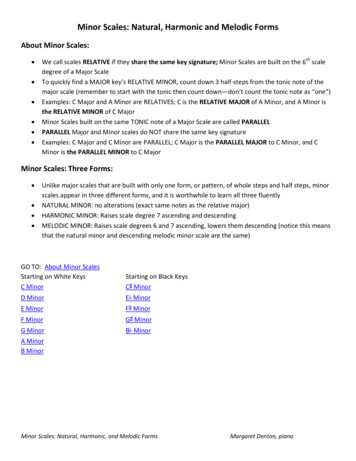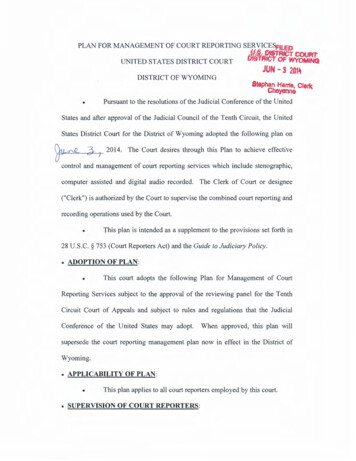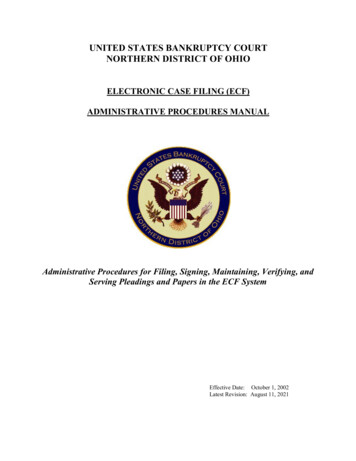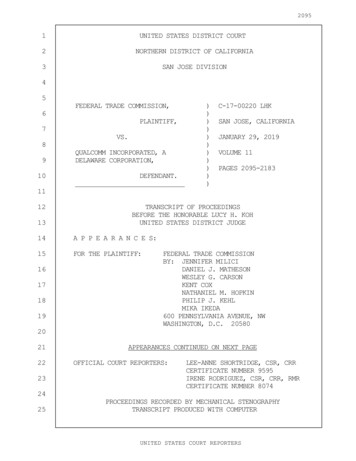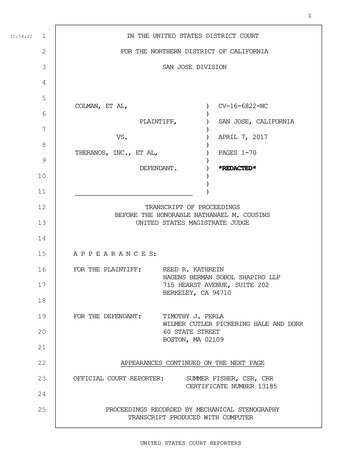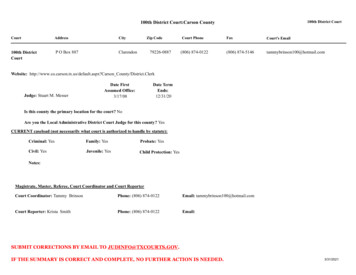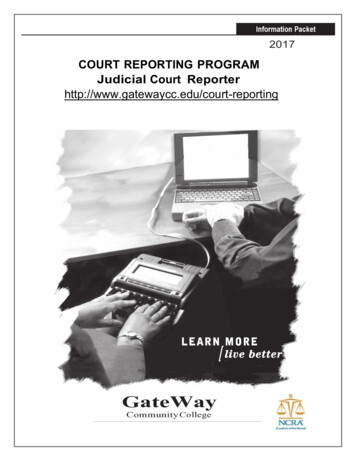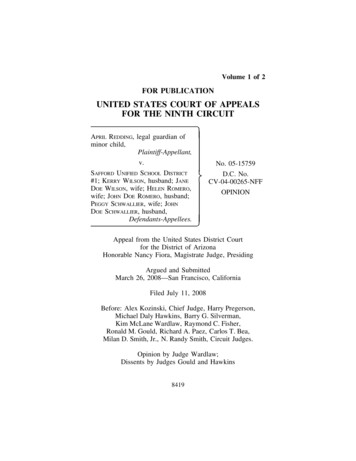
Transcription
Volume 1 of 2FOR PUBLICATIONUNITED STATES COURT OF APPEALSFOR THE NINTH CIRCUITAPRIL REDDING, legal guardian ofminor child,Plaintiff-Appellant,v.SAFFORD UNIFIED SCHOOL DISTRICT#1; KERRY WILSON, husband; JANEDOE WILSON, wife; HELEN ROMERO,wife; JOHN DOE ROMERO, husband;PEGGY SCHWALLIER, wife; JOHNDOE SCHWALLIER, husband,Defendants-Appellees. No. 05-15759D.C. No.CV-04-00265-NFFOPINION Appeal from the United States District Courtfor the District of ArizonaHonorable Nancy Fiora, Magistrate Judge, PresidingArgued and SubmittedMarch 26, 2008—San Francisco, CaliforniaFiled July 11, 2008Before: Alex Kozinski, Chief Judge, Harry Pregerson,Michael Daly Hawkins, Barry G. Silverman,Kim McLane Wardlaw, Raymond C. Fisher,Ronald M. Gould, Richard A. Paez, Carlos T. Bea,Milan D. Smith, Jr., N. Randy Smith, Circuit Judges.Opinion by Judge Wardlaw;Dissents by Judges Gould and Hawkins8419
REDDING v. SAFFORD UNIFIED SCHOOL DIST. #18423COUNSELGraham A. Boyd, M. Allen Hopper, Adam B. Wolf, ACLUFoundation, Santa Cruz, California; Andrew J. Petersen(argued), Humphrey & Peterson, P.C., Tucson, Arizona;Bruce G. Macdonald, McNamara, Goldsmith, Jackson &Macdonald, Tucson, Arizona; Daniel Joseph Pochoda, ACLUof Arizona, Phoenix, Arizona, for the plaintiff-appellant.Matthew W. Wright (argued), David K. Pauole, Holm WrightHyde & Hays PLC, Phoenix, Arizona, for the defendantsappellees.Carolyn I. Polowy, Sherri Morgan, National Association ofSocial Workers, Washington, D.C.; David A. Honzo, Julie M.Carpenter, Michael A. Hoffman, Jenner & Block LLP, Washington, D.C., for amici curiae The National Association ofSocial Workers and the National Association of Social Workers, Arizona Chapter.Clint Bolick, The Rose Law Group, Scottsdale, Arizona; JohnW. Whitehead, Douglas R. McKusick, The Rutherford Institute, Charlottesville, Virginia, for amicus curiae The Rutherford Institute.
8424REDDING v. SAFFORD UNIFIED SCHOOL DIST. #1OPINIONWARDLAW, Circuit Judge, with whom Judges PREGERSON, FISHER, PAEZ, M. SMITH, and N.R. SMITH join:On the basis of an uncorroborated tip from the culpableeighth grader, public middle school officials searched futilelyfor prescription-strength ibuprofen by strip-searching thirteenyear-old honor student Savana Redding. We conclude that theschool officials violated Savana’s Fourth Amendment right tobe free from unreasonable search and seizure. The strip searchof Savana was neither “justified at its inception,” New Jerseyv. T.L.O., 469 U.S. 325, 341 (1985), nor, as a grossly intrusivesearch of a middle school girl to locate pills with the potencyof two over-the-counter Advil capsules, “reasonably related inscope to the circumstances” giving rise to its initiation. Id.Because these constitutional principles were clearly established at the time that middle school officials directed andconducted the search, the school official in charge is not entitled to qualified immunity from suit for the unconstitutionalstrip search of Savana.I.BACKGROUNDNestled next to the Pinaleno Mountains in southeastern Arizona, Safford is a small community of slightly under 10,000residents. With a modest population, Safford maintains a single middle school that draws additional students from otherneighboring small towns. In the late summer of 2003, Savanabegan a new school year as an eighth grader at Safford Middle School along with approximately 200 other thirteen- andfourteen-year-old classmates.11As with many middle schools throughout our circuit, Safford MiddleSchool educates sixth through eighth graders. See WEBSTER’S THIRD NEWINTERNATIONAL DICTIONARY 1430 (1986) (defining middle school as “adivision in some private or public schools embracing or approximatelyembracing the upper elementary grades”). Traditionally, middle schoolstudents range in age from eleven to fourteen.
REDDING v. SAFFORD UNIFIED SCHOOL DIST. #18425On October 8, Savana was attending math class whenAssistant Principal Kerry Wilson opened the classroom doorand instructed her to pack up her belongings and accompanyhim to his office. Savana complied, gathered her things andfollowed Wilson down the hallway. Upon arriving at Wilson’s office, Savana noticed a planner that she had lent a fewdays earlier to her classmate, Marissa, sitting open on theassistant principal’s desk. While Savana immediately recognized the planner, she had not previously seen the objectscontained in the planner, including knives, a lighter and a cigarette. None of the objects belonged to Savana.Wilson then began interrogating Savana. Wilson firstreminded her of the importance of truth and asked her whoowned the planner. Savana admitted that she owned the planner and had lent it to Marissa.2 Upon further questioning,Savana insisted that none of the objects contained in the planner belonged to her.Wilson then directed Savana’s attention to a few smallwhite ibuprofen pills sitting on his desk. Possession of thesepills violated school rule J-3050’s prohibition against bringingany prescription or over-the-counter drug onto campus without prior permission. He asked Savana if she had anything todo with the pills. Savana replied that she had never seen thosepills before entering Wilson’s office. Further, she assuredWilson that she had never brought any prescription pills intothe middle school or provided any students with ibuprofen.Dissatisfied with the results of his questioning, Wilsonasked Savana whether he could search her belongings. Savanaagreed to this search. Along with his administrative assistant,Helen Romero, Wilson rummaged through Savana’s backpack and found nothing. Even though this first search of2Savana had let Marissa use the planner because Marissa wanted to hidesome things from her parents; specifically, cigarettes, a lighter and somejewelry.
8426REDDING v. SAFFORD UNIFIED SCHOOL DIST. #1Savana’s backpack supported her statement that she had notbrought pills onto campus, and despite Savana’s disciplinefree history at the school, Wilson asked Romero to takeSavana to the nurse’s office for a second, more thoroughsearch.There, at Wilson’s behest, Romero and the school nurse,Peggy Schwallier, conducted a strip search of Savana. Theofficials had Savana peel off each layer of clothing in turn.First, Savana removed her socks, shoes and jacket for inspection for ibuprofen. The officials found nothing. Then, Romeroasked Savana to remove her T-shirt and stretch pants. Embarrassed and scared, Savana complied and sat in her bra andunderwear while the two adults examined her clothes. Again,the officials found nothing. Still progressing with the search,despite receiving only corroboration of Savana’s pleas thatshe did not have any ibuprofen, Romero instructed Savana topull her bra out to the side and shake it. Savana followed theinstructions, exposing her naked breasts in the process. Theshaking failed to dislodge any pills. Romero next requestedthat Savana pull out her underwear at the crotch and shake it.Hiding her head so that the adults could not see that she wasabout to cry, Savana complied and pulled out her underwear,revealing her pelvic area. No ibuprofen was found. Theschool officials finally stopped and told Savana to put herclothes back on and accompany Romero back to Wilson’soffice. Savana did not freely agree to this search. She was“embarrassed and scared, but felt [she] would be in moretrouble if [she] did not do what they asked.” In her affidavit,Savana described the experience as “the most humiliatingexperience” of her short life, and felt “violated by the stripsearch.”The long and attenuated route to Savana began at theschool dance held to celebrate the beginning of the new academic year. There, school officials detected the smell of alcohol around a small group of students, including Savana andher classmate Marissa, and became concerned that they may
REDDING v. SAFFORD UNIFIED SCHOOL DIST. #18427have drunk alcohol either before or during the school function. Increasing their suspicion of alcohol use that night,school officials found a bottle of alcohol, along with a packof cigarettes, in the girls’ bathroom. Nothing, however, specifically linked Savana or any other individual student to theempty bottle. Nevertheless, school officials remained warythat students were violating school rule J-3050, which prohibits the possession of alcohol and the non-medical use, possession, or sale of a drug, among other school rules. Enforcementof these school regulations drove the public school officials’increased efforts toward rooting out the ibuprofen.On October 1, nearly a month and a half after the dance,and a week before the search of Savana, Jordan, a student atSafford Middle School, and his mother requested a meetingwith Principal Robert Beeman and Wilson. During the meeting, Jordan’s mother recounted how her son had become violent and gotten sick to his stomach a few nights earlier. Jordanhad confessed to his mother that he became sick after ingesting pills he received from some unspecified classmate. Moregenerally, Jordan advised the school administrators that “certain students” brought drugs and weapons on campus. Nothing in the record indicates that Jordan suggested Savana wasamong the students bringing drugs into the middle school. Tothe contrary, Jordan brought up Savana’s name only to accuseher family of providing alcohol to other students before theopening dance, an allegation the Reddings deny.3Before the opening bell on the day of the strip search, Jordan approached Assistant Principal Wilson with a small whitepill. Jordan explained that Marissa—he did not mention3Because the School District brought the motion for summary judgment,we must construe the record in the light most favorable to the Reddings.See Bank of New York v. Freemont Gen. Corp., 523 F.3d 902, 909 (9thCir. 2008) (“[W]e must view the evidence on summary judgment in thelight most favorable to the non-moving party and draw all reasonableinferences in favor of that party.”).
8428REDDING v. SAFFORD UNIFIED SCHOOL DIST. #1Savana’s name—had just given him the pill, and that a groupof students planned to take the pills at lunchtime. Consistentwith events he recounted during his meeting with Wilson theprevious week, Jordan did not link Savana with possession ofany pills or the plan for their distribution that day. Wilsonthen walked down the hall to ask Nurse Schwallier if shecould identify the pill. Schwallier recognized it as 400 mgibuprofen, obtainable only by prescription. Ibuprofen is mostcommonly found in over-the-counter Advil or Motrin in 200mg pills to treat headaches, muscle-aches, or, for many youngwomen, menstrual cramps. See PDR for NONPRESCRIPTIONDRUGS, DIETARY SUPPLEMENTS, AND HERBS 725-26 (29th ed.2008).Wilson then walked toward Marissa’s classroom to question her about the ibuprofen. Interrupting the class, Wilsonasked Marissa to gather her things and accompany him to hisoffice. As Marissa collected her belongings, Wilson noticeda black planner in the desk situated next to her. He asked theclassroom teacher to determine the owner of the planner.Opening the planner, the classroom teacher found smallknives, a cigarette lighter and a cigarette. No pills, however,were found in the planner. Wilson took the planner andMarissa to his office.Once back in his office, Wilson asked Romero to observewhile Marissa followed Wilson’s direction to turn out herpockets and open her wallet. This search revealed severalwhite ibuprofen pills identical to the one turned over by Jordan, along with a blue Naprosyn 200 mg pill.4 Wilson askedMarissa how she obtained the blue pill. Caught red-handedwith pills in violation of school rules, Marissa responded, “Iguess it slipped in when she gave me the IBU 400s.” Wilson4Naprosyn, like ibuprofen, is used to treat pain and inflammation. SeePHYSICIAN’S DESK REFERENCE 2725 (62nd ed. 2008). It is most commonlyfound in Aleve, a popular over-the-counter choice to treat discomfortrelated to menstrual cramps.
REDDING v. SAFFORD UNIFIED SCHOOL DIST. #18429asked, “Who is she?” Marissa responded “Savana Redding.”Marissa, however, did not indicate to Wilson that Savana currently had any pills on her person, or, more specifically, hadhidden pills in a place where a strip search would locate them.Wilson then asked Romero to escort Marissa down toNurse Schwallier’s office for a more intensive search foradditional ibuprofen pills. Romero asked Marissa to removeher socks and shoes so that they could be searched. Marissacomplied. Then Romero asked Marissa to pull up her shirtand pull out the band of her bra. Finding nothing, Romerolastly asked Marissa to take off her pants and stretch out theelastic on her underwear. The search failed to reveal any additional ibuprofen.5 After this search, Wilson and the schoolofficials turned their attention to Savana.The crucial link—indeed, the only link—between Savanaand the ibuprofen was Marissa’s statement upon being caughtwith the pills that the ibuprofen (and the blame) was not hers,but rather was Savana’s. Before Marissa implicated Savana,there had been no connection between Savana and the circulating rumors of prescription drugs on campus. Savana hadnever been disciplined for any infraction of school rules, letalone possession or distribution of drugs. The tip provided byJordan only linked Marissa to the ibuprofen and failed toinclude any mention of Savana. Indeed, even the plannerSavana lent to Marissa failed to provide any connectionbetween Savana and any ibuprofen because the pills had beenfound on Marissa’s person, not inside the planner. Nevertheless, on the sole basis of Marissa’s attempt to shift the schoolofficials’ focus off herself and onto Savana, and without addi5Inexplicably, although Marissa was the one found with the pills, thesearch conducted on Marissa was less intrusive than that later conductedon Savana, whose only link to the pills was Marissa’s uncorroborated“tip.” School officials asked Marissa only to lift her shirt, not to removeit entirely, as they did with Savana. The third student suspect was a boynamed Chris. He was the only student suspected of the same infractionthat day not required to strip for the school officials’ inspection.
8430REDDING v. SAFFORD UNIFIED SCHOOL DIST. #1tional questioning or investigation, Wilson directed his assistant and the school nurse to require a thirteen-year-old todisrobe.Upset after hearing what happened to her daughter, AprilRedding, Savana’s mother, made an appointment with theschool administrators. Apparently unsatisfied by the meeting,the Reddings brought suit in the District Court for the Districtof Arizona against Safford Unified School District #1, Wilson, Romero and Schwallier (collectively, “Appellees”).Appellees ultimately filed a motion for summary judgment,asserting that the defense of qualified immunity precludedthem from suit. Defendants’ motion relied solely on the argument that the strip search did not violate Savana’s FourthAmendment rights, and “because there was no constitutionalviolation, no further inquiry is necessary.” In a series of declarations, Wilson, Romero and Schwallier attempted to justifythe strip search of Savana with a general concern that “[t]heschool has a history of problems with students using and distributing prohibited and illegal substances on campus,” and auniform recounting of events—none of which remotely connected Savana with the presence of ibuprofen on the middleschool campus that day.The district court ruled for defendants entirely on the basisthat there was no violation of Savana’s constitutional right, asestablished by T.L.O., to be free from unreasonable searchesin school. It accepted as sufficient Appellees’ representationthat Savana’s decision to lend Marissa her planner provideda sufficient nexus between the two girls to corroborate Marissa’s tip. The district court reasoned that this connection justified the strip search at its inception by providing Appelleeswith reasonable grounds for suspecting that a strip search ofSavana would turn up the ibuprofen. Moreover, the districtcourt concluded that the need to locate the ibuprofen was sufficiently urgent that the strip search was “reasonably related”to the search’s objective and was not “excessively intrusive.”
REDDING v. SAFFORD UNIFIED SCHOOL DIST. #18431The conclusion that Savana’s constitutional rights were notviolated rendered consideration of the second step of qualifiedimmunity—whether the right was clearly established—unnecessary.Upon appeal, a divided panel of our court upheld the grantof summary judgment in favor of Appellees. The two-judgemajority—in a now vacated opinion—concluded that“[a]mple facts supported Marissa’s veracity as an informant,”justifying Wilson’s subsequent search of Savana, includingher ownership of the planner and the disputed allegations ofher distribution of alcohol to students. Redding v. SaffordUnified Sch. Dist. #1, 504 F.3d 828, 834 (9th Cir. 2007), r’hgen banc granted, 514 F.3d 1383. The majority found the stripsearch permissible in scope because “the strong interest” inprotecting students from prescription drugs outweighed theintrusion caused by the search the panel thought was conducted in a “reasonable manner.” In dissent, Judge Thomasasserted that the majority had misapplied Supreme Courtauthority. While a search may have been justified, the panelfailed to undertake “the appropriate inquiry [of] whether astrip search was justified.” Id. at 837 (Thomas, J. dissenting).Because it “was unreasonable to force Savana, a thirteenyear-old girl, to expose her breasts and pubic area to schoolofficials” while they searched for ibuprofen, Judge Thomasconcluded that the strip search failed to meet constitutionalmuster under T.L.O. Id. at 838.A majority of our judges in regular active service voted toreconsider en banc whether the strip search violated Savana’sFourth Amendment rights, and, if so, whether those rightswere clearly established in October 2003, when the schoolofficials conducted the strip search. See FED. R. APP. P. 35.We now consider these questions en banc.
8432REDDING v. SAFFORD UNIFIED SCHOOL DIST. #1II.DISCUSSIONThe Supreme Court has instructed that lower courts followa careful two-step process when evaluating assertions of qualified immunity. Saucier v. Katz, 533 U.S. 194, 200 (2001).First, we determine whether “[t]aken in the light most favorable to the party asserting the injury, . . . the facts allegedshow the officer’s conduct violated a constitutional right.”Clement v. Gomez, 298 F.3d 898, 903 (9th Cir. 2002) (quotingSaucier, 533 U.S. at 201). If we answer that question in theaffirmative, we then answer whether the violated right was“clearly established.”6 Id. We review de novo the districtcourt’s grant of summary judgment on the basis of qualifiedimmunity. Blankenhorn v. City of Orange, 485 F.3d 463, 470(9th Cir. 2007).A.The Constitutionality of the Strip SearchIn 1985, the United States Supreme Court held: “It is nowbeyond dispute that the Federal Constitution, by the virtue ofthe Fourteenth Amendment, prohibits unreasonable searchesand seizures by state officers. Equally indisputable is theproposition that the Fourteenth Amendment protects the rightsof students against encroachment by public school officials.”T.L.O., 469 U.S. at 334 (internal quotation marks and citations omitted). The Court stated “[t]hat [schools] are educating the young for citizenship is reason for scrupulousprotection of Constitutional freedoms of the individual, if weare not to strangle the free mind at its source and teach youthto discount important principles of our government as mere6Because the district court and the majority of the three judge paneldecided that a constitutional right was not violated, we, sitting en banc, arerequired to decide that question. It is of no consequence at this junctureof the appeal in which order the Saucier questions are addressed. It is notnecessary, therefore, to defer decision pending the Supreme Court’s decision whether to overrule Saucier’s two-step inquiry. See Pearson v. Callahan, S. Ct. , 2008 WL 754340 (Mar. 24, 2008).
REDDING v. SAFFORD UNIFIED SCHOOL DIST. #18433platitudes.” Id. (citing W. Va. State Bd. of Educ. v. Barnette,319 U.S. 624, 637 (1943)).[1] To implement these principles, the Court established“the proper standard for assessing the legality of searchesconducted by public school officials.” Id. at 328. Whetherschool officials subject a student to a search of her purse, asin T.L.O., or strip a student of clothing, the Constitution mandates that the search meet the generalized requirement of“reasonableness, under all the circumstances, of the search.”Id. at 341. The Court recognized that what is reasonablerequires a balancing of interests: “On one side of the balanceare arrayed the individual’s legitimate expectations of privacyand personal security; on the other, the government’s need foreffective methods to deal with breaches of public order.” Id.at 337. Noting that “even a limited search of the person is asubstantial invasion of privacy,” id. (citing Terry v. Ohio, 392U.S. 1, 24-25 (1968)), the Court emphasized that “[a] searchof a child’s person or of a closed purse or other bag carriedon her person, no less than a similar search carried out on anadult, is undoubtedly a severe violation of subjective expectations of privacy.” Id. at 337-38. Weighed against the students’substantial interest in privacy is the “substantial interest ofteachers and administrators in maintaining discipline in theclassroom and on school grounds.”7 Id. at 339. To accommodate the school context, the Court concluded that the “publicinterest is best served by a Fourth Amendment standard ofreasonableness that stops short of probable cause.” Id. at 341.[2] The Court set forth a twofold inquiry to gauge reasonableness: “[F]irst, one must consider ‘whether the . . . action7Judge Hawkins’s dissenting opinion gives little weight to the substantial privacy interests of the child identified by the Supreme Court, focusingalmost entirely on the school’s interest in order. Yet the Supreme Courtinstructed that the reasonableness standard involved two equally importantgoals: preserving the school’s need for order while ensuring that the “interests of students would be invaded no more than is necessary” to preserve such order. Id. at 343.
8434REDDING v. SAFFORD UNIFIED SCHOOL DIST. #1was justified at its inception;’ second, one must determinewhether the search as actually conducted ‘was reasonablyrelated in scope to the circumstances which justified the interference in the first place.’ ” Id. (citations omitted). The Courtfurther held that a search will be permissible in its scope“when the measures adopted are reasonably related to theobjectives of the search and not excessively intrusive in lightof the age and sex of the student and the nature of the infraction.” Id. at 342. The Court crafted this test to “neither undulyburden the efforts of school authorities to maintain order intheir schools nor authorize unrestrained intrusions upon theprivacy of schoolchildren.” Id. at 342-43.While Judge Hawkins’s dissenting opinion characterizesT.L.O.’s standard as designed to “spare teachers and schoolofficials the necessity of schooling themselves in the nicetiesof probable cause and permit them to regulate their conductaccording to the dictates of reason and common sense,” Hawkins Dissent infra at 8456, it pays scant attention to the critically important statement of the Court that immediatelyfollows this quoted sentence in the T.L.O. opinion: “At thesame time, the reasonableness standard should ensure that theinterests of students will be invaded no more than is necessaryto achieve the legitimate end of preserving order in theschools.” Id. at 343 (emphasis added).Nowhere does the T.L.O. Court tell us to accord schoolofficials’ judgments unblinking deference. Nor does T.L.O.provide blanket approval of strip searches of thirteen-yearolds remotely rumored to have had Advil merely because ofa generalized drug problem. Rather, the Court made it clearthat while it did not require school officials to apply a probable cause standard to a purse search, it plainly required themto act “according to the dictates of reason and commonsense.” Id. As discussed below, the public school officialswho strip searched Savana acted contrary to all reason andcommon sense as they trampled over her legitimate and substantial interests in privacy and security of her person.
REDDING v. SAFFORD UNIFIED SCHOOL DIST. #184351. Public School Officials Conducted a Strip Search ofSavana.[3] Let there be no doubt: the Safford school officials conducted a strip search of Savana. Judge Hawkins’s dissentingopinion squeamishly avoids facing the reality of the nature ofthe search. Our designation of Savana’s search as a stripsearch is supported by federal and state law, as well as secondary authority. Savana did not have to be completely nakedfor the school officials to have strip searched her. The Eleventh Circuit has considered a police officer’s direction forsomeone to strip down to their underwear to be a “stripsearch.” See Justice v. City of Peachtree City, 961 F.2d 188,190 (11th Cir. 1992). Likewise, the Fourth Circuit understands a search of an adult arrestee in his boxer shorts to bea strip search. See Amaechi v. West, 237 F.3d 356, 363 (4thCir. 2001) (citing United States v. Dorlouis, 107 F.3d 248,256 (4th Cir. 1997)). The First Circuit “recognize[s] that astrip search may occur even when an inmate is not fully disrobed.” See Wood v. Hancock County Sheriff’s Dep’t., 354F.3d 57, 63 n.10 (1st Cir. 2003).Statutes defining a strip search in several states confirm ourunderstanding of the term “strip search.” California, forinstance, defines the term as “requir[ing] a person to removeor arrange some or all of his or her clothing so as to permita visual inspection of the underclothing, breasts, buttocks, orgenitalia of such person.” CAL. PENAL CODE § 4030 (emphasissupplied); see also, e.g., CONN. GEN. STAT. § 54-33k; 725 ILL.COMP. STAT. 5/103-1; MO. REV. STAT. § 544.193; N.J. STAT.ANN. 2A:161A-3; VA. CODE ANN. § 19.2-59.1; WASH. REV.CODE § 10.79.070. The Fourth Circuit has recognized that thisdefinition of a strip search is “uniform” throughout the Union.See Amaechi, 237 F.3d at 365 n.15.Black’s Law Dictionary defines a ‘strip search’ as “[a]search of a person conducted after that person’s clothes havebeen removed, the purpose usually being to find any contra-
8436REDDING v. SAFFORD UNIFIED SCHOOL DIST. #1band the person might be hiding.” See BLACK’S LAWDICTIONARY 1378-79 (8th ed. 2004).Savana was required by the public school officials to disrobe and expose the parts of her body underneath her underwear so that school officials could potentially find ibuprofen.The term may unsettle the sensibilities of our dissenting colleagues; however, the accuracy of the designation merelycements the intrusiveness of what occurred. And, even if ourdissenting friends want to quibble about the term, the searchof Savana by any other name would be equally as unreasonable.2.Was the Strip Search Justified at Its Inception?[4] “Under ordinary circumstances, a search of a student bya teacher or other school official will be ‘justified at its inception’ when there are reasonable grounds for suspecting thatthe search will turn up evidence that the student has violatedor is violating either the law or the rules of the school.”T.L.O., 469 U.S. at 341-42. Reasonableness, of course,depends on context. We agree with the Seventh Circuit thatT.L.O. requires that “as the intrusiveness of the search of astudent intensifies, so too does the standard of Fourth Amendment reasonableness. What may constitute reasonable suspicion for a search of a locker or even a pocket or pocketbookmay fall well short of reasonableness for a nude search.”8Cornfield by Lewis v. Consol. High Sch. Dist. No. 230, 991F.2d 1316, 1321 (7th Cir. 1993). The Second Circuit alsoagrees with this approach: “Although T.L.O. held that reasonable suspicion is the governing standard, the reasonableness8Notably, at least seven states—including two in this Circuit—haveconcluded that strip searches of schoolchildren are never permissible forany reason. See CAL. EDUC. CODE § 49050; IOWA CODE § 808A.2(4)(a);OKLA. STAT. tit. 70, § 24-102; N.J. STAT. ANN. § 18A:37-6.1; S.C. CODEANN. § 59-63-1140; WASH. REV. CODE § 28A.600.230(3); WIS. STAT.§ 948.50(3).
REDDING v. SAFFORD UNIFIED SCHOOL DIST. #18437of the suspicion is informed by the very intrusive nature of astrip search, requiring for its justification a high level ofsuspicion.” Phaneuf v. Fraikin, 448 F.3d 591, 596 (2d Cir.2006) (citation omitted).Here, as in T.L.O., the school officials engaged in tworelated searches: first, a search of Savana’s backpack and herpockets, which does not give rise to the claims in the complaint, and second, a strip search, which forms the basis of thecomplaint.9 See T.L.O., 469 U.S. at 345 (“The incident thatgave rise to this case actually involved two separate searches,with the first—the search for cigarettes—providing the suspicion that gave rise to the second—the search for marihuana.”). A review of the facts found in T.L.O., and the Court’sreasoning regarding the progression of the first search ofT.L.O. to the second, supports the conclusion that while reasonable suspicion may very well have justified the initialsearch of Savana’s backpack and the emptying of her pockets,it was unreasonable to proceed from this first search to a stripsearch.In T.L.O., a high school teacher discovered two girls smoking in a lavatory in violation of a school rule. 469 U.S. at 328.In response, the teacher brought the two girls down to theprincipal’s office to discuss the infraction with the highschool’s vice principal. While T.L.O.’s friend admitted tosmoking, in violation of a school rule, T.L.O. denied the allegation. Id. To determine whether to belie
3Because the School District brought the motion for summary judgment, we must construe the record in the light most favorable to the Reddings. See Bank of New York v. Freemont Gen. Corp., 523 F.3d 902, 909 (9th Cir. 2008) ("[W]e must view the evidence on summary judgment in the light most favorable to the non-moving party and draw all reasonable
